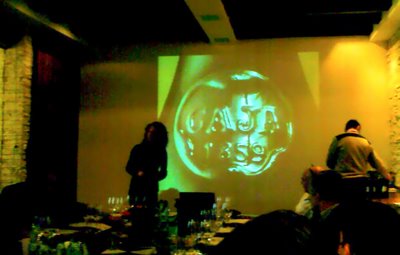8 wines from Angelo Gaja
Posted on 5 February 2009

This was surely evident in the three Ca’ Marcanda bottlings: rich, fat, dense, low-acid, lavishly oaked wines with a fair bit of sensual excitement, but ultimately a bit boring. Surely the Toscana IGT Promis 2006 (Merlot dominating, with the balance Syrah and Sangiovese) is excessively alcoholic, macerated-fruity and soft-tannic; defined as an ‘everyday wine’ of this estate, it is in fact too big for that. So how to rate such an anonymous but qualitative wine? On to Toscana IGT Magari 2006 (Cabernet Sauvignon and Franc supporting Merlot): still alcoholic but more driven and elegant than the Promis, with better balance. In short, less Merlotish (or Shirazish). Finish is really long, and while hardly very complex or individual this is really showing top-drawer winemaking and fruit quality. The estate’s flagship Bolgheri Ca’ Marcanda 2004 (similar blend) is dense, sweet, fleshy, but less atractively fresh than the above. Little evolution; a very big, very modern wine.
I was excited to try the Brunello di Montalcino Rennina 2004 and Brunello Sugarille 2004, my first taste of bottled Brunello from this outstanding vintage. But more patience will be required: they showed really tight. In general, the Rennina disappointed: no architectural interest, medium length at best, and not terribly Sangiovese-typical. The Sugarille was in another league, on the riper side of ripe but balanced, improving with airing, with a clean essential core of good cherry fruit. The style is very modern (you know it is when Sangiovese smells of menthol) but I can’t really criticise it too much. Price is the only issue.
Contrarily to past years, when we tasted the entire Gaja range including the white wines, only three bottles from Piedmont were opened. I can’t really be bothered with the Barolo Dagromis 2003, a blend of Serralunga and La Morra vineyards (akin to mixing milk chocolate with ice, perhaps), a moderately modern but carefully unacidic wine with a floral, sweet, cherryish nose and soft palate (perhaps forgivable for a 2003). It would be a good middle-of-the-road Barolo from an unknown producer but we can expect more from Gaja. And he surely delivers with the Barbaresco 2004. This is the most traditional wine here – still blended from the original 14 vineyards selected by Giovanni Gaja in the 1970s – and has consistently been the most interesting of the range in recent years, while the expensive crus here have been increasingly massaged to soft-tannic oblivion. A ‘real’ expression of Nebbiolo, peppery and sturdy, unsimplistic, not too fruity, not too modern, concentrated, with a good finish, a certain semi-traditional elegance and silky texture. Young of course, I have faith it should move into the ‘outstanding’ category with five years, or ten. Finally the Langhe Nebbiolo Sperss 2000. Technically a Barolo from Serralunga d’Alba vineyards, but declassified into Langhe DOC since 1997; 6% Barbera is currently blended in (‘for more fruit brilliance’, a Gaja manager once explained; as if Nebbiolo didn’t have enough). Unevolved in colour but slowly constructing a more aged bouquet with notes of raw and stewed meat, a certain sweet cherry elegance, and decent breadth; a nicely balanced, very pleasing glassful on the palate with quite some tannic reserve to improve further. But shows a certain limitedness of 2000: just a little muffled and unvivid.

This tasting was consistent with my other recent encounters with Gaja wines. At the entry level they can be quite simple and a little heavy (especially those from Bolgheri), while the upper bottlings are undoubtedly classy, with balance, structure and potential to age well. And clearly Gaja is no more in the vanguard of iconoclastic modernism in Piedmont; other producers have pushed the frontier quite a bit farther. In fact, compared to the hyperoaky roto-fermented (and at times concentrator-aided) ‘Nebbiolos’ from Elio A. or Gianni V., Gaja is now looking like an old Italian gentleman, perhaps driving a tad fast in his sports car.
So what is the problem? Prices. The above bottles combined would have settled you no less than 500€. Gaja’s blended Barbaresco is 70€ per bottle retail in Italy; crus are north from 150€. The ‘everyday’ Promis is 20+€. There are legion equally good Barbarescos at half the price. But then, of course, Gaja has become a ‘global brand’.

